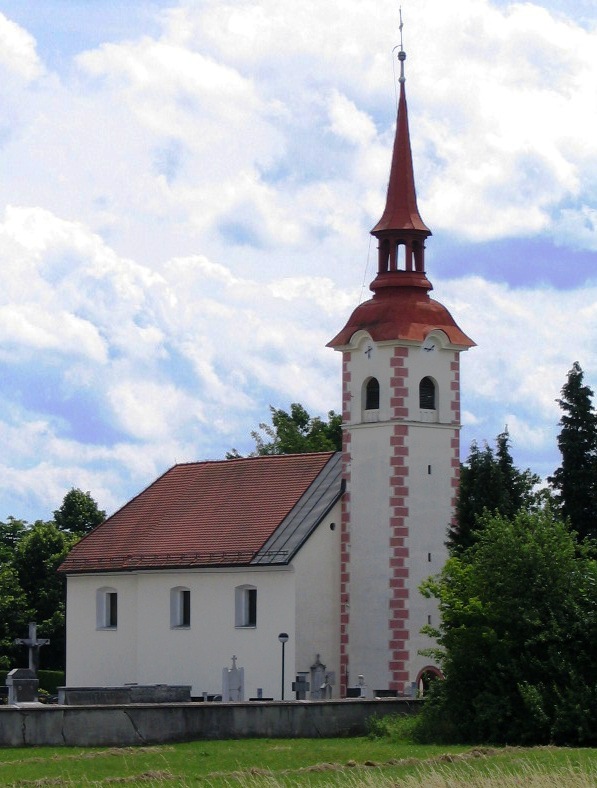Stožice (Ljubljana) on:
[Wikipedia]
[Google]
[Amazon]
Stožice ( or ; german: Stoschze''Leksikon občin kraljestev in dežel zastopanih v državnem zboru,'' vol. 6: ''Kranjsko''. 1906. Vienna: C. Kr. Dvorna in Državna Tiskarna, p. 108.) is a formerly independent settlement in the northern part of the capital
 The church in Stožice is dedicated to
The church in Stožice is dedicated to
Stožice on Geopedia
{{DEFAULTSORT:Stozice Localities of the Posavje District, Ljubljana Ljubljana Posavje
Ljubljana
Ljubljana (also known by other historical names) is the capital and largest city of Slovenia. It is the country's cultural, educational, economic, political and administrative center.
During antiquity, a Roman city called Emona stood in the ar ...
in central Slovenia
Slovenia ( ; sl, Slovenija ), officially the Republic of Slovenia (Slovene: , abbr.: ''RS''), is a country in Central Europe. It is bordered by Italy to the west, Austria to the north, Hungary to the northeast, Croatia to the southeast, an ...
. It is part of the traditional region of Upper Carniola
Upper Carniola ( sl, Gorenjska; it, Alta Carniola; german: Oberkrain) is a traditional region of Slovenia, the northern mountainous part of the larger Carniola region. The centre of the region is Kranj, while other urban centers include Jeseni ...
and is now included with the rest of the municipality in the Central Slovenia Statistical Region
The Central Slovenia Statistical Region ( sl, Osrednjeslovenska statistična regija) is a statistical region in central Slovenia.
Geography
This is the second-largest region in terms of territory. It has a total area of 2,555 km², with a ...
.
Geography
Stožice lies between the former settlements ofJežica
Ježica (; german: Jeschza) is a formerly independent settlement in the northern part of the capital Ljubljana in central Slovenia. It is part of the traditional region of Upper Carniola and is now included with the rest of the municipality in the ...
and Tomačevo, the hamlet of Brinje, and the historical territory of the City of Ljubljana along both sides of the former main road to Domžale
Domžale (; german: Domschale)''Leksikon občin kraljestev in dežel zastopanih v državnem zboru,'' vol. 6: ''Kranjsko''. 1906. Vienna: C. Kr. Dvorna in Državna Tiskarna, p. 24. is a town and the seat of Municipality of Domžale. The town lies ...
(''Dunajska cesta'' 'Vienna Street'). Stožice developed from a core settlement of farms east of the road on a terrace above the Sava River
The Sava (; , ; sr-cyr, Сава, hu, Száva) is a river in Central and Southeast Europe, a right-bank and the longest tributary of the Danube. It flows through Slovenia, Croatia and along its border with Bosnia and Herzegovina, and finally t ...
. The soil is sandy and fertile.
Name
The name ''Stožice'' is derived from the Slovene common noun ''stog'' 'stack of hay', referring to local agricultural practices. In the past the German name of the village was ''Stoschze''.History
The walls of a square Roman structure were discovered in the north part of the Stožice cemetery in 1880. Associated finds included a coin from the 4th century. Roman tiles and graves have also been found at the Urbanček farm in Stožice. Before the Second World War, a textile factory and a vinegar and yeast factory operated in the village. Important economic activities also included sales of foodstuffs, especially milk and eggs, to Ljubljana.''Krajevni leksikon Dravske Banovine''. 1937. Ljubljana: Zveza za tujski promet za Slovenijo, p. 349. After the war, there was extensive private construction in the Stožice. The southern part of Stožice (79 houses with a population of 628) was annexed by Ljubljana in 1935. The remainder of Stožice was annexed by the City of Ljubljana in 1974, ending its existence as an independent settlement.''Spremembe naselij 1948–95''. 1996. Database. Ljubljana: Geografski inštitut ZRC SAZU, DZS.Church
Saint George
Saint George (Greek: Γεώργιος (Geórgios), Latin: Georgius, Arabic: القديس جرجس; died 23 April 303), also George of Lydda, was a Christian who is venerated as a saint in Christianity. According to tradition he was a soldier ...
. It is late Gothic or even earlier in style and was first mentioned in written sources in 1526. It has been remodeled several times. The furnishings of the church are primarily the work of Andrej Rovšek and date from the early 20th century. The church cemetery was established in 1797, when it was transferred from the parish church in Ježica. The cemetery contains a memorial to 104 victims of the Second World War.
Notable people
Notable people that were born or lived in Stožice include: * Alojzij Merhar (a.k.a. Silvin Sardenko) (1876–1942), poet, writer, playwright, and editor * Franc Pavlovec (1897–1959), painter * France Presetnik (1913–1997), actor * Franci Presetnik (1916–1974), actorReferences
External links
*Stožice on Geopedia
{{DEFAULTSORT:Stozice Localities of the Posavje District, Ljubljana Ljubljana Posavje